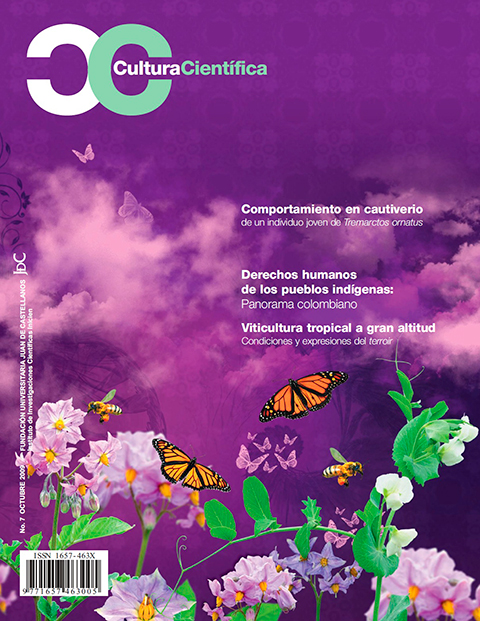Keywords:
radiation, temperature change extent, short days, grape ripeningAbstract
During 1982 started our wine growing project at the Puntalarga Hill, between 2500 and 2600 meters a.s.l.: 5.78 ºN, 72.98 ºW, on the East Andes mountains chain. Pinot noir, white Riesling and Riesling x Silvaner crossings are the most planted grapevines. Since 1984 research and development activities are carried out on pertinent subjects. Low latitude, high altitude, relatively low rainfall, frequent atmospheric transparency, determines intensity and spectral composition of incident solar radiation as well as temperature's day/night change extent and low night values that are the tropical highland's climate features of the region. Vine behavior and grape and wine characteristics indicate that, local climatic conditions could be considered thermally equivalent to those of selected, well known temperate wine growing regions. Coexistence over the year of all grapevine developmental stages and the production of vintages with good sugar content and acidity levels, suitable for the production of wine remarkable in aroma and color intensity, are possible under those conditions. At the territories of the project, the climatic conditions over the year are equivalent to those of autumnal wine grape ripening time in a temperate climate. At the same time solar radiation flow is relatively constant and UV-B rich. Both factors result in special features of local grapes, which could be considered as being terroir expressions.
Downloads
References
BORMAN, J.. et al. 1997. Ultraviolet radiation as a stress factor and the role of protective pigments. In Plants and UV-B, P. Lumsden ed. The University Press, Cambridge.
CHAPARRO, G. 2001. Asimilación carbónica de la vid Vitis vinífera L. en condiciones de altitud tropical: alta irradiancia UV-B. Tesis, Biología, Universidad Nacional, Bogotá.
CURRLE, et al. 1983. Biologie der Rebe. Meininger, Neustadt an der Weinstrasse.
DE ROSA T. 1990 Tuttovini. Mondadori, Milán.
DRAWERT, F., Rapp A. 1964 Die Biotechnologische Reihe des Weines. Vitis, Ber. Rebenforschung, 4, 262-266.
FAUST, M. 2000. Physiological considerations for growing temperate-zone fruit crops in warm climates. In temperate fruit crops in warn climates, Ammon Erez (ed.) Kluwer Academic Press, Dordrecht. 137-156.
FREGONI, C. y PEZZUTTO S. 2000. Principes et premières approches de l'indice bioclimatique de qualité de Fregoni. Progrès Agricole et Viticole 117, 18, 390-396.
FREGONI, M. 2005. Viticoltura di Qualita. Phytoline, 37010 Affi.
GALET, P. 1983. Précis de viticulture. Les climats équatoriaux. Imprimerie Dehan, Montpellier.182-183.
HARLFINGER, O. y FORMAYER H. 2005. Die mesoklimatische Bedingungen fuer den Weinbau in Oesterreich. Bull O.I.V., 78, n° 887 – 888, pp 7 – 16.
HUGLIN, P. 1986. Biologie et écologie de la vigne. Payot, Lausanne.
HUGLIN, P., SCHNEIDER, Ch. 1998 Biologie et écologie de la vigne, 2e édition. Lavoisier, Paris.
JACKSON, J. 2000. Light regimes in temperate fruit-tree orchards grown at low latitudes. In temperate fruit crops in warm climates, Ammon Erez (ed.). Kluwer Academic Press, Dordrecht. 1 -15.
KRUPA, S. et al. 1998. Global Climate and UV-B radiation. In Elevated Ultraviolet (UV) – B Radiation and Agriculture. Springer Verlag, Berlin.
KSENZHEK, O. y Volkov, A. 1998. Plant Energetics. Academic Press, San Diego.
LEVINE, D. 1994. L'or des dieux, l'or des Andes. UNESCO, Serpenoise, Metz.
QUIJANO NIÑO, M. 1970. Memorias. Hacienda San Marcos, Sogamoso.
QUIJANO-RICO, M. 1987. El cultivo de vides nobles y la producción de vinos de alta calidad en Boyacá. Integración Boyacense, Tunja, 13, 13-06.
______2004. Ecología de una Conexión Solar: de la adoración del sol al desarrollo vitivinícola regional. Cultura Científica, Tunja. 2, 5-9.
______2007a. Great highland's wine growing: low latitude agroclimatic compensation through altitude. XXX. Word Congress of Vine and Wine, Budapest.
______2007b. El Chicamocha: Rio del Vino de Gran Altura. Cultura Científica, Tunja, No.5, 36-43.
_______2008a. Viticulture tropicale à grande altitude. Conditions et expressions du terroir. Congrès Terroirs, Nyon, Suiza.
_______2008b. La Región del Sol de Oro. Terroir y Biotecnología de la Información. Cultura Científica, Tunja, No.6, 5-11.
SÁNCHEZ, A., QUIJANO-RICO, M. 2008. Transparencia atmosférica y amplitud térmica en Puntalarga. Informe Interno. Viñedo de Puntalarga, Nobsa.
PRETORIUS, I. y HOJ, P. 2005. Grape and wine biotechnology. Aus. J. Grape and Wine Res. 11, 83-108.
ROBIN, J. 2000. Reflexión du sol et coloration du raisin. L'exitation de la vigne par la lumière rouge serait determinante pour la qualité des baies. J. Int. Sci. Vigne et Vin, 34, 101-119.
SCHULTZ H, R., et al. 1998. Is grape composition affected by current levels of UV-B radiation?. Vitis, 37, 191-192.
SCHWERDTFEGER, W. 1976. World survey of climatology. Climates of Northern South America. Colombia. 12, 358-380.
SEGUIN, G. 1983. Influence des terroirs viticoles sur la constitution et la qualité des vendages. Bull. OIV, 5b, 623, 2-18
TEVINI, M., et al. 1981. Some effects of enhanced UV-B irradiation on the growth and composition of plants. Planta 153, 388-394.
TONIETTO, J. 1999. Les macroclimats viticoles mondiaux et l'influence du mésoclimat sur la typicité de la Syrah et du Muscat d'Hambourg dans le sud de la France. Méthodologie de charactérization. Thèse de Doctorat. ENSA, Montpellier.
ZOLTY, A. 1987. Pour quand les grands vignobles tropicaux?. Agriculture et développement rural. Marchés Tropicaux 2192 - 3023.





